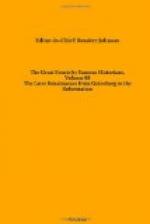In the months of May and June, 1485, two acts of faith were celebrated in Saragossa, capital of Aragon, and a large number of New Christians burned alive. The public was enraged, certainly, but helpless; yet not so helpless but that many awoke to a conviction that, since the inquisitors had resorted to terror for the conservation of the faith, they ought to be restrained by terror in their turn.
In the night of September 14, 1485, one of the inquisitors, Pedro Arbues, covered as usual with a coat of mail under his robes, and wearing a steel skull-cap under his hat—for he was every moment conscious of guilt and apprehensive of retribution—took a lantern in one hand and a bludgeon in the other; and, like a sturdy soldier of his peculiar Church, walked from his house to the cathedral of that same Saragossa, to join in matins. He knelt down by one of the pillars, setting his lantern on the pavement. His right hand held the weapon of defence, yet stealthily half covered with the cloak. The canons, in their places, were chanting hymns. Two men came and knelt down near him. They understood, as most Spaniards do, how most effectually to attack a man, and how to kill him quickest. Therefore one of them suddenly disabled him on one side by a blow on the left arm. The other swung his cudgel at the back of his head, just below the edge of the steel cap, and laid him prone. He never spoke again, but expired in a few hours. This murder, as might be expected, was well made use of by the priests, serving them to plead the necessity of an inquisition to repress violence; and the inhabitants of the city were instantly overawed by a display of high judicial authority which they had no power to resist.




